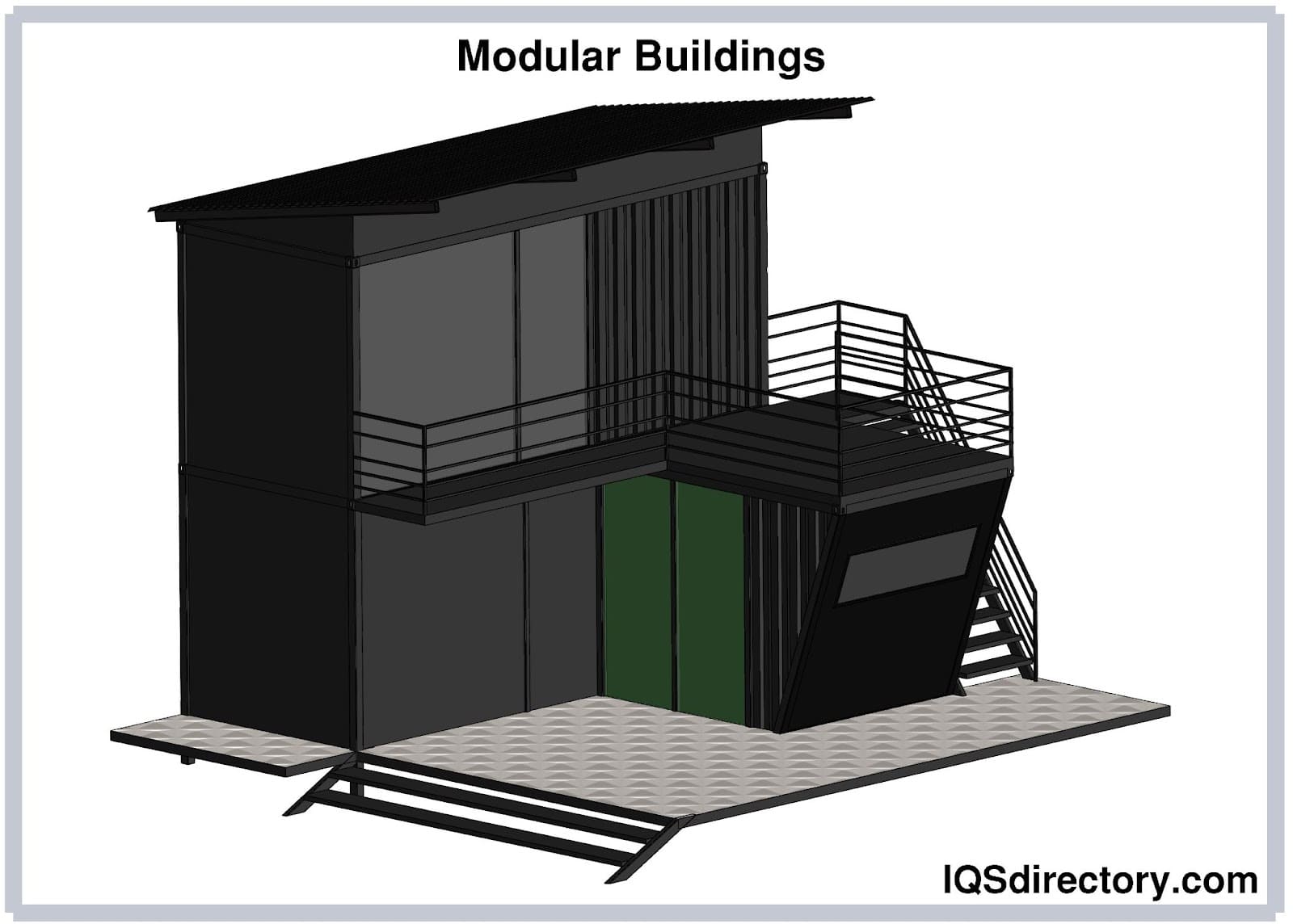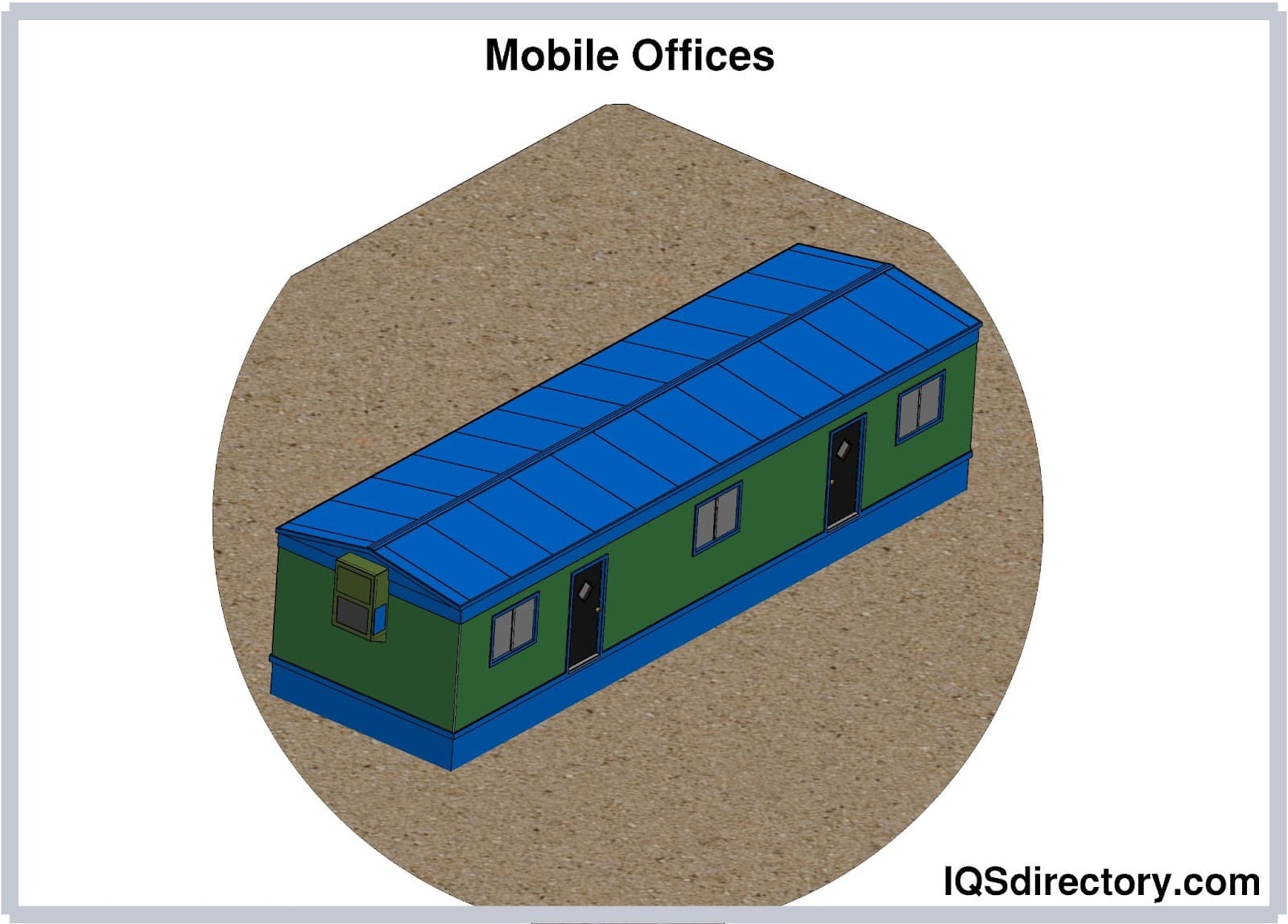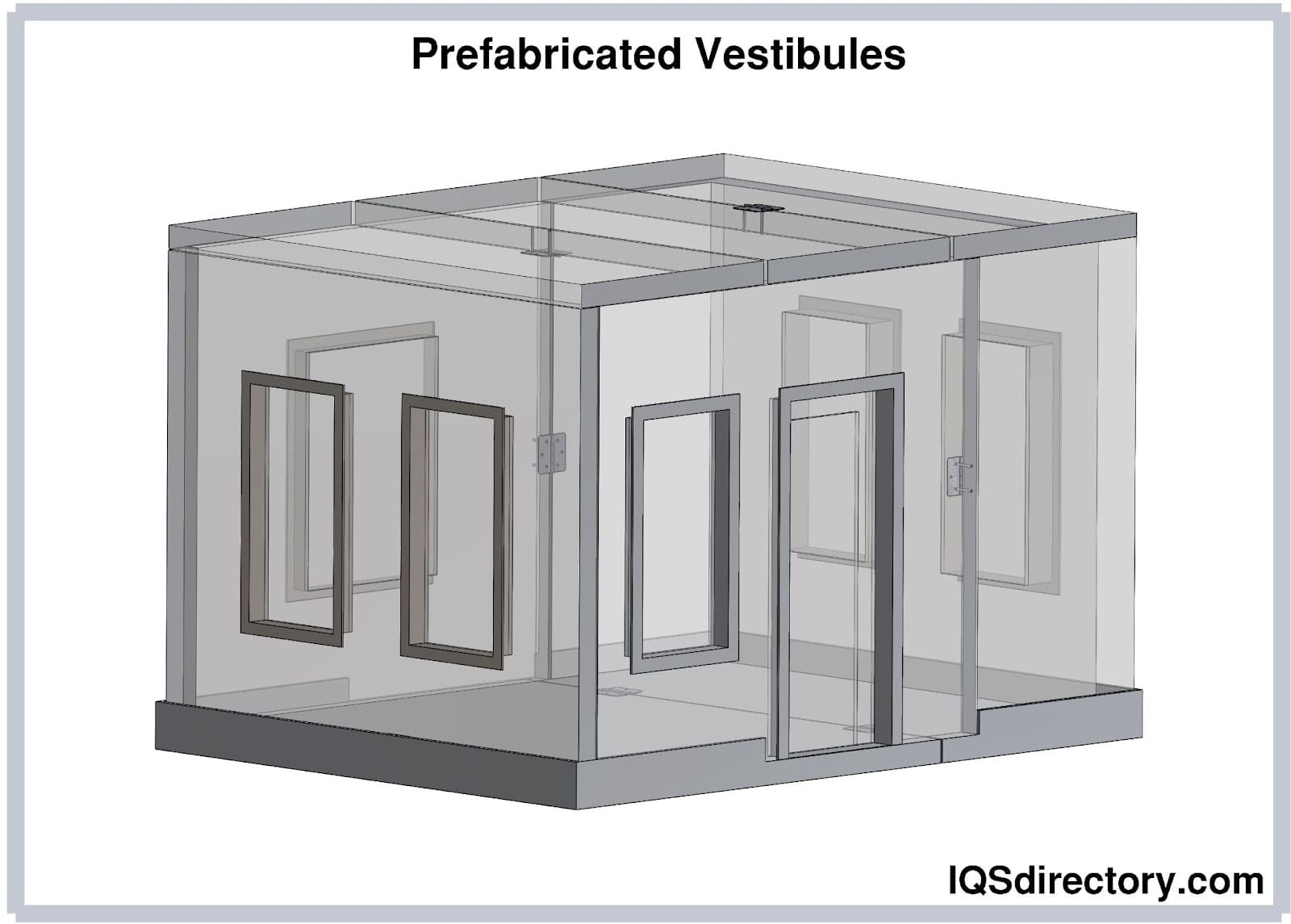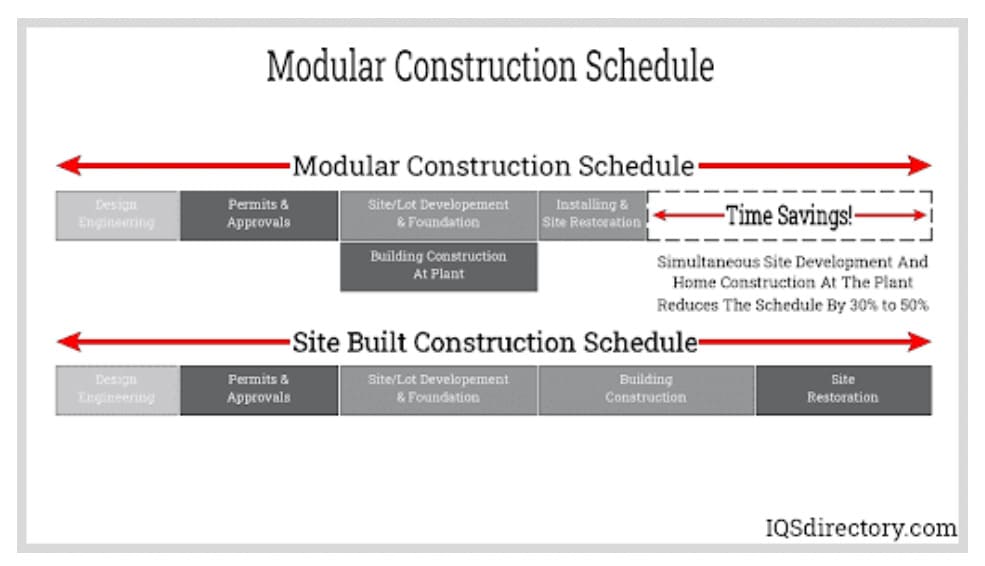Modular Buildings
Modular buildings are prefabricated structures constructed offsite and assembled at the intended location. They offer a cost-effective, time-saving alternative to traditional brick-and-mortar construction.
The terms "prefabricated building" and "modular building" are often used interchangeably. Modular refers to being made of standardized units or sections for easy construction and flexible configuration, while prefabricate means manufacturing components offsite for quick assembly. All modular buildings are prefabricated, but not all prefabricated buildings are modular.
Modular Buildings FAQ
What is the difference between modular and prefabricated buildings?
All modular buildings are prefabricated, but not all prefabricated buildings are modular. Modular buildings are made of standardized sections for flexible layouts, while prefabricated refers to components built offsite for quick assembly.
How fast can modular buildings be constructed?
Modular buildings are typically completed in weeks rather than months. Offsite fabrication and stock designs reduce delays from weather, labor shortages, and material availability, making projects finish about twice as fast as traditional builds.
Are modular buildings environmentally friendly?
Yes. Modular construction reduces waste, lowers site traffic, and produces less emissions. Materials can be reused, and modules can be dismantled, relocated, or renovated, making them a sustainable building solution with improved indoor air quality.
What materials are modular buildings made from?
Modular buildings can be constructed from lumber, polyvinyl, or metals like steel and aluminum. Steel is often preferred for large structures such as garages because of its durability, corrosion resistance, and strength in harsh climates.
Can modular buildings be customized to specific needs?
Yes. Modular buildings can include custom foundations, HVAC, plumbing, electrical systems, and interior finishes. Ceiling heights, layouts, and aesthetics are often tailored to blend with existing structures or meet unique project requirements.
What are common uses for modular buildings?
Modular buildings serve as offices, classrooms, hospitals, guardhouses, disaster relief shelters, storage facilities, mining camps, and residential units. They are used for both temporary and permanent applications across the U.S., including remote areas.
Do modular buildings meet local building codes?
Yes. Modular buildings comply with the same national and local codes as traditional structures. Before installation, local permits and industry-specific requirements such as ADA or FDA standards must be reviewed and approved.
The History of Modular Buildings
Modular buildings first gained popularity as an alternative to traditional construction in the early 1900s; between 1910 and 1940, Sears Roebuck Co. sold more than 500,000 modular homes.
Following World War II, demand for modular buildings increased further. The Baby Boom led to many returning soldiers seeking housing and starting families, creating a surge in real estate needs. Traditional construction methods could not meet this rapid demand, so builders turned to modular construction, which enabled them to construct homes faster and at a lower cost than conventional on-site building.
While modular structures in the 1950s tended to be smaller, advancements since the 1980s have allowed manufacturers to create larger and highly customized modular buildings. In recent decades, modular building construction methods have become more advanced, improving the assembly and on-site installation of modules. Today, large modules are shipped nationwide and assembled using heavy-duty cranes with capacities exceeding 100 tons.
Modular buildings are now a common part of the built environment; nearly all Americans have been inside a pre-engineered building, whether they realize it or not. The use of modular and prefabricated buildings continues to grow due to advantages such as lower costs, faster construction, portability, and the ability to build in a wide range of locations.
Modular buildings can be utilized as permanent or temporary solutions, indoors, outdoors, or within existing structures. In remote areas with limited access to traditional building materials, factory-built modular buildings offer a practical and efficient construction solution.
Advantages of Modular Buildings
Modular buildings are widely used due to their numerous benefits. Key advantages include cost efficiency, rapid installation, consistent factory-controlled quality, eco-friendliness, and ease of expansion or relocation.
- Assembly Speed
- The primary benefit of modular construction is reduced build time, though actual timelines depend on design complexity, engineering, and delivery. Generally, modular building projects progress from design to completion in just a few weeks.
- Prefabricated buildings are completed faster than conventional buildings for several reasons. Many modular buildings use existing stock designs, eliminating the need for custom design work. During construction, modules are simply assembled on-site rather than being built from scratch, and the process is less affected by material or labor shortages and weather delays. Modular buildings are typically produced according to strict schedules in controlled factory environments, and some manufacturers guarantee delivery within a set timeframe.
- Building Versatility
- Modular buildings offer outstanding flexibility. Manufacturers can design them as additions to current structures, partitions within existing rooms, or stand-alone buildings. Since modules are standardized, users can rearrange layouts as their needs evolve.
- Environmentally Friendly Buildings
- Modular construction is environmentally friendly, producing less waste and enabling more precise construction than traditional methods. Offsite manufacturing reduces on-site traffic and emissions. These portable buildings can be dismantled, moved, or renovated for ongoing use, conserving resources. Using dry materials in construction also delivers better indoor air quality, contributing to sustainability.
Modular Building Design
- Modular Construction Process
- Modular buildings are created by joining modules to form integrated wall, floor, and roof assemblies. Off-site construction uses advanced factory equipment, and on-site assembly involves placing modules side-by-side, end-to-end, or stacking them to create different layouts and designs.
- Each module is engineered to withstand challenging weather, transportation, and lifting conditions.
- Building Materials
- Modular buildings can be constructed from lumber, polyvinyl, or metals such as steel or aluminum. The choice of material depends on factors like size, location, and intended use. Steel building is a preferred option for large structures, such as prefabricated garages, due to its strength, corrosion resistance, and durability in harsh weather.
- Modular Building Customization
- Manufacturers can prefabricate modular buildings with any components required, including walls, floor trusses, various window types, complete HVAC systems, plumbing, electrical wiring, lighting, and interior finishes.
- Although prefab buildings are often made from standard designs, manufacturers can customize modular buildings to your specifications. They consider factors such as foundation requirements, load-bearing needs, environmental conditions (like heavy winds or snow), and preferred aesthetics (from professional office styles to vibrant colors and trims). Modular buildings can blend seamlessly with existing architecture and are often indistinguishable from traditionally built structures.
- Common modular customizations include building extensions, interior partitions, and small enclosures. Manufacturers also frequently adjust ceiling heights, wall thicknesses, and other dimensions to meet specific requirements.
Modular Building Images, Diagrams and Visual Concepts
 Modular buildings consist of standardized sections manufactured in controlled environments away from the final building site.
Modular buildings consist of standardized sections manufactured in controlled environments away from the final building site.
 Relocatable buildings are constructed for reuse and can be easily transported to different locations as needed.
Relocatable buildings are constructed for reuse and can be easily transported to different locations as needed.
 Prefabricated shelters offer safe outdoor spaces that protect occupants from harsh weather, pollution, and debris.
Prefabricated shelters offer safe outdoor spaces that protect occupants from harsh weather, pollution, and debris.
 The construction timeline for modular buildings is typically about half that of traditional construction projects.
The construction timeline for modular buildings is typically about half that of traditional construction projects.
Modular Building Types
- Aluminum Buildings
- Constructed from lightweight, corrosion-resistant aluminum, these buildings are valued for their durability and adaptable sizing options.
- Booth Manufacturers
- Produce portable, enclosed steel structures for uses like security checkpoints, revenue collection, access control, and gate houses.
- Building Systems
- Utilize prefabricated components to assemble permanent buildings efficiently.
- Bullet-Proof Structures
- Engineered to meet standards for resisting bullet impacts and other high-velocity projectiles.
- Guard Houses
- Commonly used at controlled access points, serving as secure workstations for security or admissions staff. Sizes vary depending on site requirements.
- Metal Buildings
- Primarily made from selected metal materials, suitable for storage, protection, or other uses in a variety of sizes.
- Mobile Offices
- Mobile offices are a type of modular construction, utilizing the same materials as those found in conventional buildings.
- These offices are often prefabricated stock units used by construction companies as temporary workspace.
- Modular Office Building
- Custom-built to meet specific customer requirements, with individual modules ranging from 10 to 18 feet wide and 36 to 76 feet long, though sizes depend on shipping regulations.
- Modular Buildings for Mining
- The Denali Building System, used in mining and portable construction, combines modular and fabric building techniques. These buildings provide housing and office solutions for mining camps, offering portability, easy installation, minimal assembly, and low shipping volume. Additional benefits include low per-person costs, larger rooms, no hard wiring, and various bathroom layouts. Vinyl flooring and glass windows enhance comfort and usability.
- Portable Buildings
- Designed for easy relocation, these buildings can be moved without major structural changes. Common examples include portable hospitals, classrooms, and offices.
- While some buildings can be both modular and portable, not all modular buildings are designed for portability. Portable buildings are typically temporary, easy to assemble and disassemble, and useful in remote or rural locations due to their versatility.
- Pre Engineered Buildings
- Constructed using prefabricated sections, these buildings function similarly to other prefabricated structures in terms of application and variety.
- Prefab Buildings
- A type of modular building created from prefabricated components.
- Prefabricated Buildings
- Unlike modular buildings, these are delivered fully assembled and available in various sizes and uses.
- Prefabricated Garages
- Modular structures commonly used to expand existing garage spaces.
- Steel Buildings
- Built mainly from steel, these structures are suitable for industrial and outdoor use, with virtually unlimited size options.
- Storage Buildings
- Often assembled from prefabricated parts, usually steel, to provide secure storage solutions.
- Walk-In Enclosures
- Enclosed modular areas large enough to enter and work within, such as guard houses, x-ray rooms, and communication rooms.
Modular Building Applications
Modular buildings are designed to deliver temporary or permanent shelter for a range of needs. They may serve as standalone buildings, interior partitions, building additions, booths, or guard houses.
Applications include churches, schools and universities, homes, classrooms, cleanrooms, gyms, hospitals, construction site offices, inplant offices, commercial modular buildings, disaster relief shelters, storage units, medical and dental offices, emergency centers, security guardhouses, and military barracks.
Modular Building Installation
After you finalize specifications and layouts, your supplier manufactures the building. Once production is complete, the modular building is delivered and assembled on-site, typically within a few days, after which it is ready for use.
Standards and Specifications for Modular Buildings
Modular buildings comply with the same building and architectural codes as traditional structures. Before installing a prefabricated building, review applicable national and local electrical and construction standards, as well as any industry-specific codes such as ADA or FDA requirements. Always check with local authorities regarding necessary permits.
Choosing a Supplier of Modular Buildings
To ensure your modular building is functional, durable, and visually appealing, selecting the right manufacturer is essential. A reputable supplier will offer free, no-obligation proposals and designs, and should handle on-site installation. For a trusted selection, review the list of quality companies we’ve curated above; all companies listed are verified and dependable.
After narrowing down your choices, visit each manufacturer’s website to explore their offerings and pricing. Contact three or four companies that interest you most, share your requirements and questions, and compare not just prices but also customer service. Choose a manufacturer who prioritizes quality and customer satisfaction.
Once you’ve selected a supplier, discuss your preferred design or layout in detail. Provide your requirements so they can present tailored modular building options, specifications, and a quote. This process will lead to your ideal modular building solution.
Accessories for Modular Buildings
Modular buildings can be equipped with various accessories. Common options include plumbing fixtures, sinks, roof vents, divider walls, windows, outlet strips, and ADA-compliant restrooms, among others.
Modular Building Terms
- Accessory
- Products added to modular buildings, such as windows, doors, roof vents, and other enhancements to basic panel structures.
- All-bolted Steel Floor
- Galvanized steel floor joists spanning across each module, bolted to both side beams for added strength.
- Aluminum
- A lightweight, corrosion-resistant metal with high conductivity, commonly used for constructing modular buildings.
- Anchor
- System used to stabilize modular or portable buildings, typically utilizing straps, cables, turnbuckles, or split bolts.
- Anodized
- Material treated with a metal oxide coating to create a durable, semi-translucent finish in a range of colors.
- Architect of Record/Engineer
- The professional responsible for overseeing the modular building project, distinct from the manufacturer’s engineer.
- Beam
- A structural component in modular buildings subjected to bending loads; types include continuous, simple, and cantilever beams.
- Bottom Board
- Material installed beneath floor joists to protect insulation and ensure weather resistance, often made of fiberglass-reinforced paper or asphalt board.
- Bracing
- Use of angled supports, cables, or rods within roofs and walls to transfer loads like wind or seismic forces to the foundation.
- Building
- An enclosed, partially enclosed, or open structure designed and constructed from components and materials to meet specific use requirements.
- Building Code
- Regulations established by recognized agencies governing building design, loads, procedures, and construction details, often specific to jurisdictions.
- Cantilever Beam
- A beam supported at only one end, with the other end free to move or bear loads.
- Cladding
- Exterior wall panels and metal roofing used on prefabricated steel buildings for protection and appearance.
- Clear-Span
- An interior space free of supporting columns.
- Collateral Loads
- Additional weight from permanent building elements beyond the main system, such as mechanical, electrical, ceilings, and partitions.
- Column
- Vertical structural member that transfers roof, truss, or beam loads to the foundation.
- Composite
- Material made from two or more substances, each retaining its beneficial properties within the final product.
- Cool Roof
- A metal roof designed to meet solar reflectance and infrared emittance standards, often painted white or using specialized reflective materials.
- Elastic Design
- Design approach utilizing material properties that allow for temporary, reversible deformation under predetermined loads.
- Fabrication
- Manufacturing process in which raw materials are transformed into finished components for prefabricated steel buildings, using welding, forming, punching, painting, and cleaning.
- Fiberglass
- Glass filaments combined with polyester resins and hardeners, molded into various shapes for building components.
- Gable
- A modular building style featuring a roof with one peak and slopes on each side.
- Galvanized Steel
- Steel that has been coated with a protective layer of zinc.
- Girt
- Horizontal structural element attached to endwall or sidewall columns, supporting wall paneling in modular buildings.
- Hardwall
- Modular building walls constructed from masonry, block, tilt-up, or precast materials.
- Installation
- The assembly of prefabricated building components on-site to create the finished portable or modular building.
- Joist
- A lightweight horizontal beam used to support roofs or floors.
- Magnetic Shielding
- Methods for reducing or blocking magnetic fields, electromagnetic, or radio frequency interference from affecting structures.
- Manufacturer's Engineer
- The engineer employed by the manufacturer, responsible for designing prefabricated steel building systems.
- Multi-Span
- Building interiors that include columns for additional support.
- Purlin
- Horizontal structural member supporting the roof covering and transferring loads to the main frame of modular buildings.
- Prefab Office
- Office buildings prefabricated offsite, typically not attached to permanent foundations.
- Prefab Shelters
- Modular structures specifically designed to provide shelter in various applications.
- Portable Offices
- Frequently used at construction sites and temporary event locations as movable office space.
- R-Value
- A measure of insulation’s resistance to heat flow, important for maintaining temperature control in buildings.
- Rigid Frame
- A structural frame with moment connections that provide stability against design loads, reducing the need for bracing.
- Roofing
- The component attached to the roof frame of modular buildings, offering weather and fire protection.
- Relocatable Buildings
- Modular structures built in factories, delivered either fully assembled or ready for quick on-site assembly.
- Single Slope
- A roof design with a single slope, often forming a peak on one side.
- Sound Attenuation
- Construction methods or materials designed to reduce noise transmission from inside modular buildings to the exterior.
- Stainless Steel
- Steel alloy known for its resistance to chemicals and corrosion.
- Steel
- An iron alloy with up to 1.8% carbon, known for its workability and strength.
- Structural Insulated Panels (SIPs)
- Prefabricated insulated panels, also called foam core panels, made of engineered laminates with a solid foam core for improved energy efficiency.
- Truss
- A structural element composed of three or more members arranged in triangles to act as a beam, supporting loads via tension or compression.
- Turnkey
- A fully outsourced product or system, delivered and installed by a subcontractor, ready for immediate use by the purchaser.